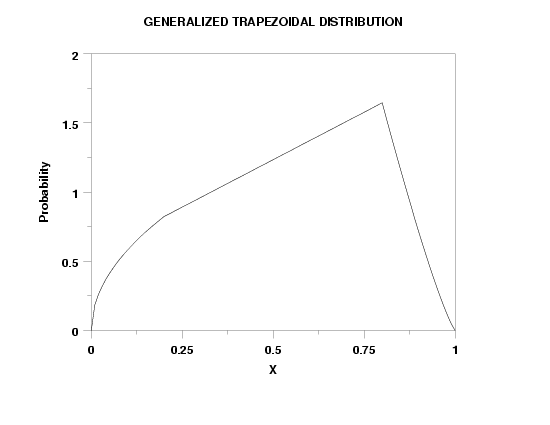

|
GTRPDFName:

where
Trapezoidal distributions may be appropriate for modeling processes that can be represented by the following three stages:
The trapezoidal model is probably the simplest model of this type (i.e., the growth and decline stages are linear and the stability stage is constant). The generalized trapezoidal distribution allows more flexibility in modeling these stages. Specifically, the growth and decay stages may exhibit nonlinear convex or concave behavioir. In addition, the stability stage may be linearly increasing or decreasing. The generalized trapezoid distribution has the following probability density function:
![f(x|a,b,c,d,nu1,nu3,alpha) =
2*alpha*nu1*nu3*((x-a)/(b-a)**(nu1-1)/
[2*alpha*(b-a)*nu3+(alpha+1)*(c-b)*nu1*nu3+2*(d-c)*nu1]
a <= x < b;
2*nu1*nu3*[(alpha-1)*((c-a)/(b-a))+1]
[2*alpha*(b-a)*nu3+(alpha+1)*(c-b)*nu1*nu3+2*(d-c)*nu1]
b <= x < c;
2*nu1*nu3*((x-a)/(b-a)**(nu1-1)/
[2*alpha*(b-a)*nu3+(alpha+1)*(c-b)*nu1*nu3+2*(d-c)*nu1]
= u*((d-x)/(d-c)) c <= x < d;
= 0 elsewhere](eqns/gtrpdf.gif)
Dorp and Kotz (see Reference below) show that the generalized trapezoid can be defined as a mixture
![fx(x) = SUM[i=1 to 3][pi(i)*f(xi)(x)] a <= x <= d; 0 elsewhere](eqns/gtrmix.gif)
where the

and
![pi(1) = 2*alpha*(b-a)*nu3/[2*alpha*(b-a)*nu3+(alpha+1)*(c-b)*nu1*nu3+2*(d-c)*nu1]](eqns/pi1.gif)
This form may be more useful for modeling and fitting.
<SUBSET/EXCEPT/FOR qualification> where <x> is a variable, number, or parameter containing values in the interval (a,d); <a> is a number, parameter, or variable that specifies the first shape parameter; <b> is a number, parameter, or variable that specifies the second shape parameter; <c> is a number, parameter, or variable that specifies the third shape parameter; <d> is a number, parameter, or variable that specifies the fourth shape parameter; <nu1> is a number, parameter, or variable that specifies the fifth shape parameter; <nu3> is a number, parameter, or variable that specifies the sixth shape parameter; <alpha> is a number, parameter, or variable that specifies the seventh shape parameter; <y> is a variable or a parameter (depending on what <x> is) where the computed pdf value is stored; and where the <SUBSET/EXCEPT/FOR qualification> is optional.
LET Y = GTRPDF(X,0,0.2,0.8,1,2,2,0.5) LET Y = GTRPDF(X,A,B,C,D,NU1,NU3,ALPHA)
TITLE GENERALIZED TRAPEZOIDAL DISTRIBUTION
LABEL CASE ASIS
X1LABEL X
Y1LABEL Probability
LET A = 0
LET B = 0.2
LET C = 0.8
LET D = 1
LET NU1 = 1.5
LET NU3 = 2.2
LET ALPHA = 0.5
PLOT GTRPDF(X,A,B,C,D,NU1,NU3,ALPHA) FOR X = A 0.01 D

Date created: 2/3/2004 |